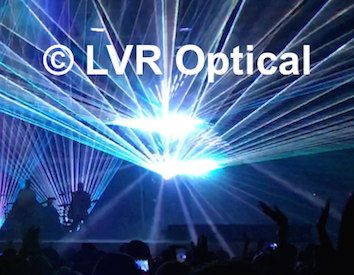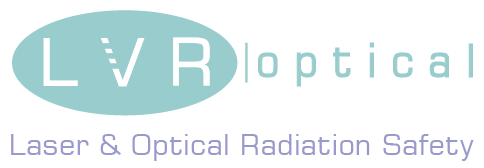
BLOG: Audience Scanning - Myths and Truths
 The purpose of this article is to tackle some of the common questions and misconceptions that exist in relation to the ever-popular subject of audience scanning laser effects, for which there is a lot of passion with many providers to use this type of laser effect. This article considers the topic from a technical/practical perspective rather than an earlier article, where the legal status of performing this type of effect was discussed.
Audience scanning, (or crowd scanning as it sometimes known), is where laser effects are intentionally direct towards spectators, so that the they may be immersed in vivid laser light.
The purpose of this article is to tackle some of the common questions and misconceptions that exist in relation to the ever-popular subject of audience scanning laser effects, for which there is a lot of passion with many providers to use this type of laser effect. This article considers the topic from a technical/practical perspective rather than an earlier article, where the legal status of performing this type of effect was discussed.
Audience scanning, (or crowd scanning as it sometimes known), is where laser effects are intentionally direct towards spectators, so that the they may be immersed in vivid laser light.
In this article I’ll explain the current status of using lasers to perform audience scanning at events.
All audience scanning effects are unsafe to view
Not true. If the laser light being directed at the audience is below the permitted exposure limit (MPE), and the projection equipment is stable and reliable, it can be safe to view.
My laser was sold with a scan-fail detector. So, it’s safe to scan with?
Just because a laser projector has a ‘scan-fail’ detector included as one of its built-in features, doesn’t make the projector inherently safe to scan with. Scan-fail detectors are intended to prevent harmful levels of laser light being emitted from the laser projector. The quality and effectiveness of the scan-fail detector function varies considerably across different manufacturers, from being virtually useless, (which a lot are), to being state-of-the-art. But even the highest quality scan-fail detectors suffer from not knowing what environment they will be used. The protection these devices offer is closely related to the minimum projection distance the laser effect and the characteristics of the laser beam itself. No scan-fail detector is going to offer sufficient protection to someone viewing a standard 5W laser projector in a small venue, where the exposure limit can be exceeded in less than 40ns. To use a scan-fail effectively the user must know its limiting characteristics and how they relate to the laser type and effect.
Audience scanning exposure is safe at a distance of 10m
Several people have quoted this one to us when performing assessments. It’s not true. Yes, lasers do lose their intensity, and therefore ability to cause harm the further away from the source the beam travels. But it is rare that a typical laser beam used for lightshow applications would create exposure levels below the limits at such a short distance. It is however possible to artificially shorten the hazard distance of a laser effect by using a Pangolin Safety Scan lens, which can be fitted to a laser projector to increase the rate at which the beam loses its concentration of energy.
Faster scanning makes it safe to view
Turning up the scan rate of a laser effect makes it appear less bright, but for the most part the change in brightness has more to do with aesthetics, rather than having a significant effect on the exposure levels.
Only stationary beams and finger beam type effects are hazardous
While these types of effects are usually the most hazardous to direct at another person, (even momentarily stationary beams), typical scanning effects such as tunnels and flat scans which create exposure durations that are a fraction of the time a beam effect can stay in the eye, do not see a similar reduction in hazard potential. Compared to a stationary beam, a finger beam effect generally reduces to being a quarter of the static beam risk. While for the continually moving laser effects such as the tunnels etc., the risk only reduces to approximately a tenth. These reductions might sound good, and in the right conditions can be utilised to create safe effects. However, if the stationary beam exposure from an unmodified 1W laser is taken to be 1000x the MPE, fast scanning of that same beam results in a reduction that is still 100x the MPE.
Some other bright stage lighting is just as harmful as lasers
Many sources used as stage lighting effects create intense dazzle that leaves a strong afterimage when viewed directly, particularly those that use arrays of LED sources. The fact the lights causes an uncomfortable afterimage is a good indicator that more light than should has entered and saturated the eye’s photoreceptors. But as uncomfortable as it is, such exposures are not yet anywhere near that created by laser effects. The dazzle risk is something that should be considered for certain situations, in particular, how it can affect a person’s ability to undertake a task, which could then lead to consequential harm. But the actual risk of such light exceeding the exposure limits is at present, low. The blog ‘Sharpys and Laser’ provides a bit more information on this topic.
Scanning red effects is safer than scanning blue laser light
Actually, this can be true. For most exposure doses created by laser light shows, the dominant injury mechanism is a thermal injury, resulting from too much light overheating parts of the eye. However, when considering blue light, there additionally exists a cumulative photochemical effect that can also damage the eye.
It’s impossible to create good looking audience scanning effects that are below the MPE
Not true. Legal audience scanning effects take more effort to produce, but with the right combination of laser power, beam divergence, and projector reliability, with some thoughtful design can still look very effective.
Audience Scanning Training Workshop
For further indepth information, LVR offer a 1 day training course "Advanced Laser Show Designers Workshop". A unique hands-on practical workshop for designers and operators of laser effects wanting to produce effects that create safe exposure levels for audience illumination.
The golden rule is, forget the myths about what may or may not be safe to do, and don’t point laser effects at people without first performing an assessment of the laser exposure levels, for both normal operation, and foreseeable fault conditions. Usually this means having an understanding of what exposure limit is permitted, and a way of measuring the actual exposure levels produced by the laser effect.
© 2018 LVR Optical
